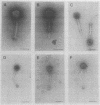Abstract
A set of 22 phages of Listeria species (listeriaphages) (21 temperate and 1 virulent) were compared on the basis of morphology and protein composition. All 22 phages had icosahedral heads and exhibited either contractile or noncontractile tails. They represented two different morphotypes. Twenty phages belonged to the Siphoviridae family and could be differentiated only on the basis of tail length. Accordingly, they could be assigned to previously defined listeriaphage species. Two other phages were classified as members of the Myoviridae family, one of which (A511) should be regarded as a new species. It was found to be substantially different from all other known listeriaphages. All phages exhibited typical protein profiles, which were determined by sodium dodecyl sulfate-polyacrylamide gel electrophoresis and subsequent laser densitometrical analysis of the gels. It was then possible to distinguish eight protein subgroups on the basis of unique protein patterns. This classification corresponds well to the previous groupings based on host range. Most of the phages revealed two or three major proteins ranging from 21 to 24 kDa and 30 to 36 kDa. In addition, at least 10 minor proteins could be observed for each phage. Our results indicate that the major proteins are structural proteins of the capsid and tail, and the protein band ranging from 30 to 35 kDa could clearly be assigned to the proteins of the phage capsid.
Full text
PDF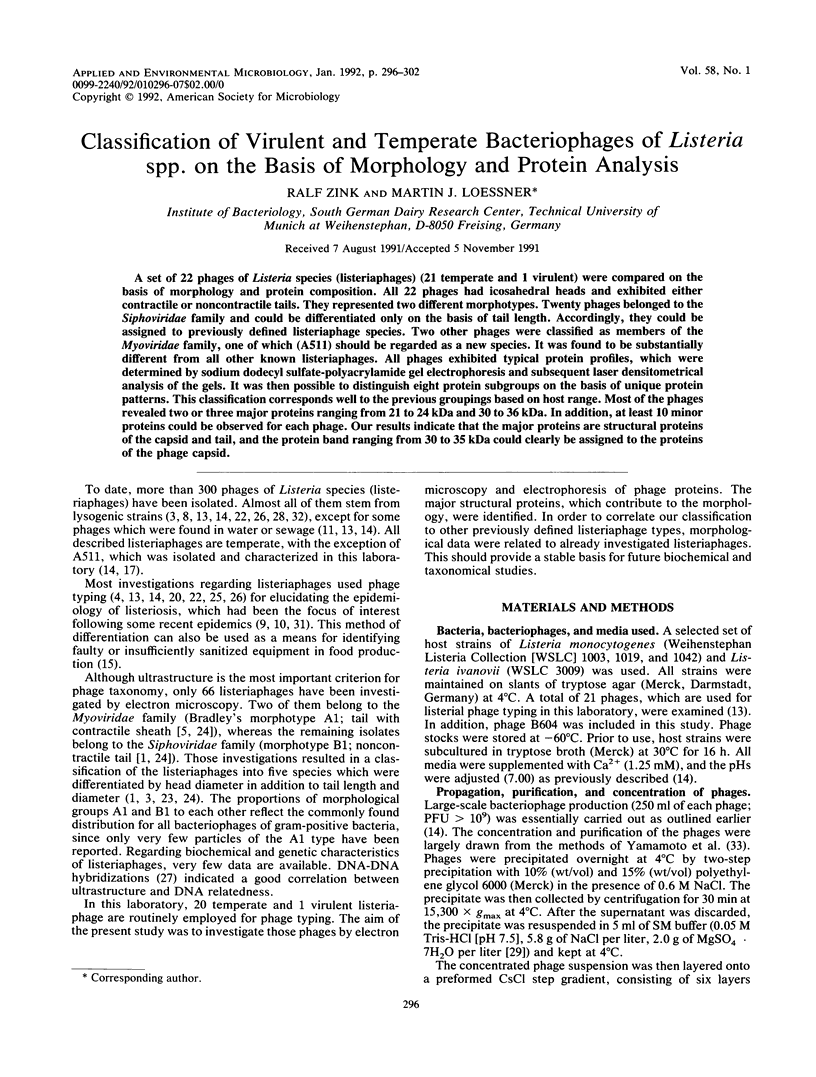
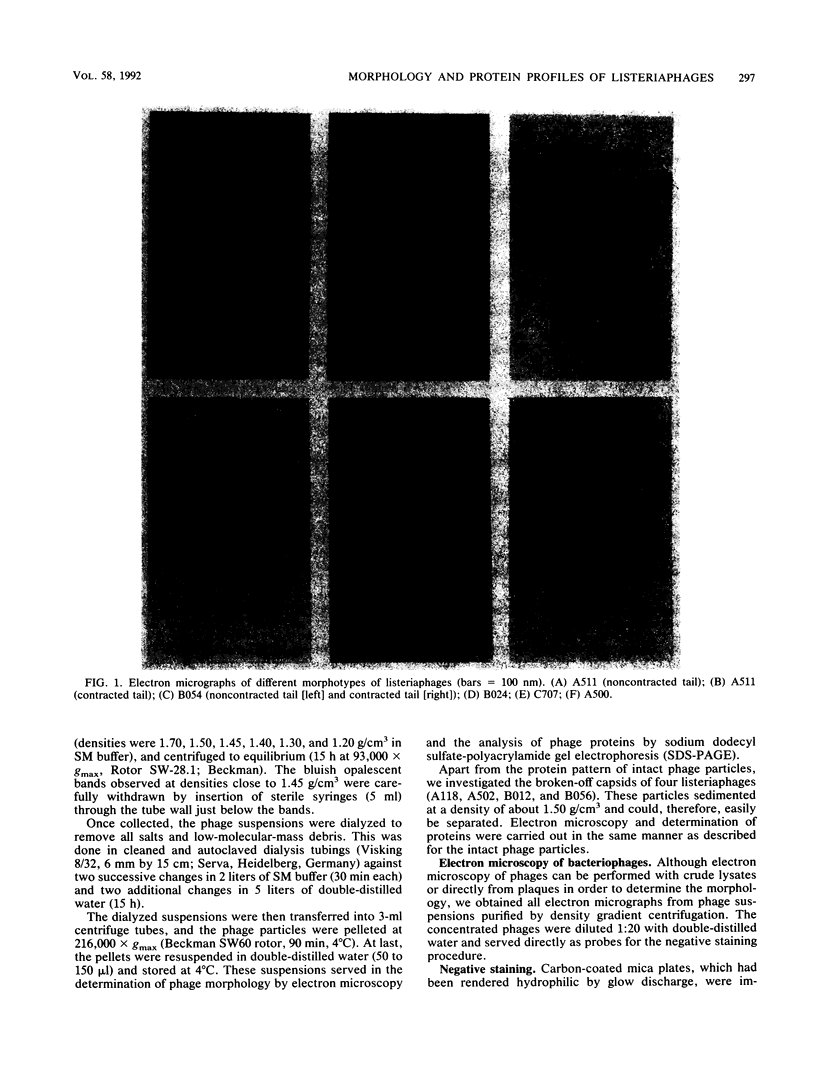
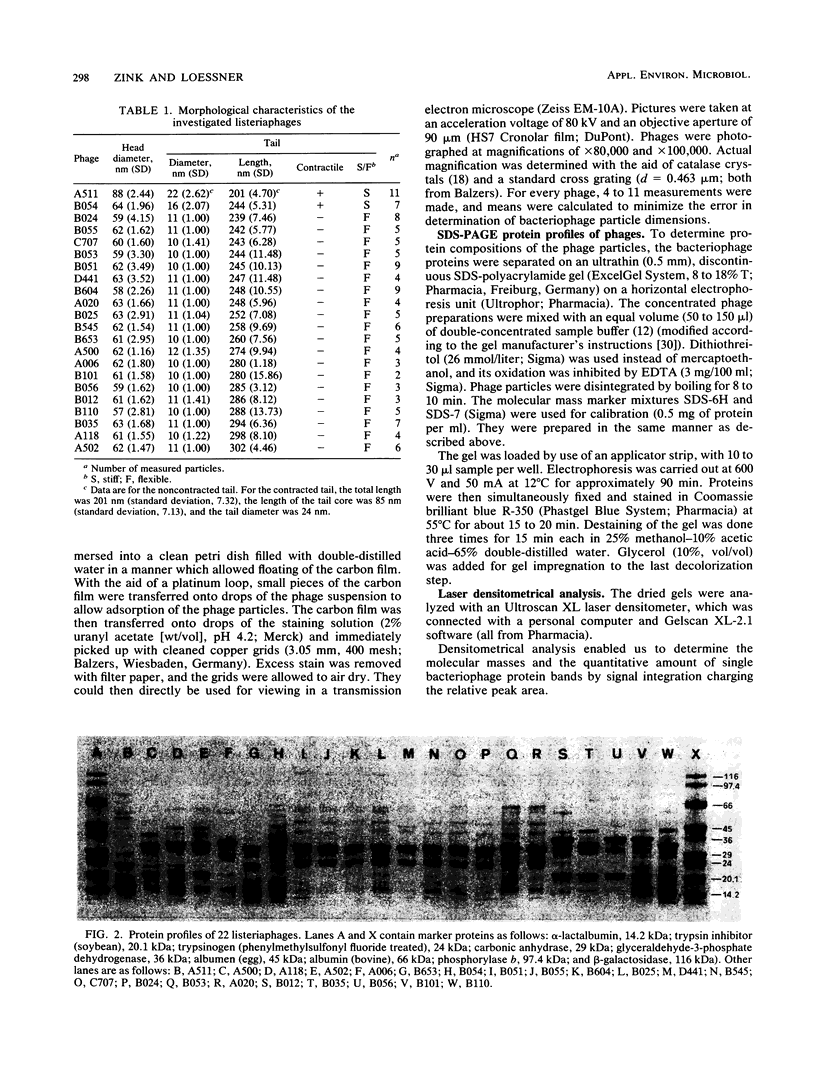
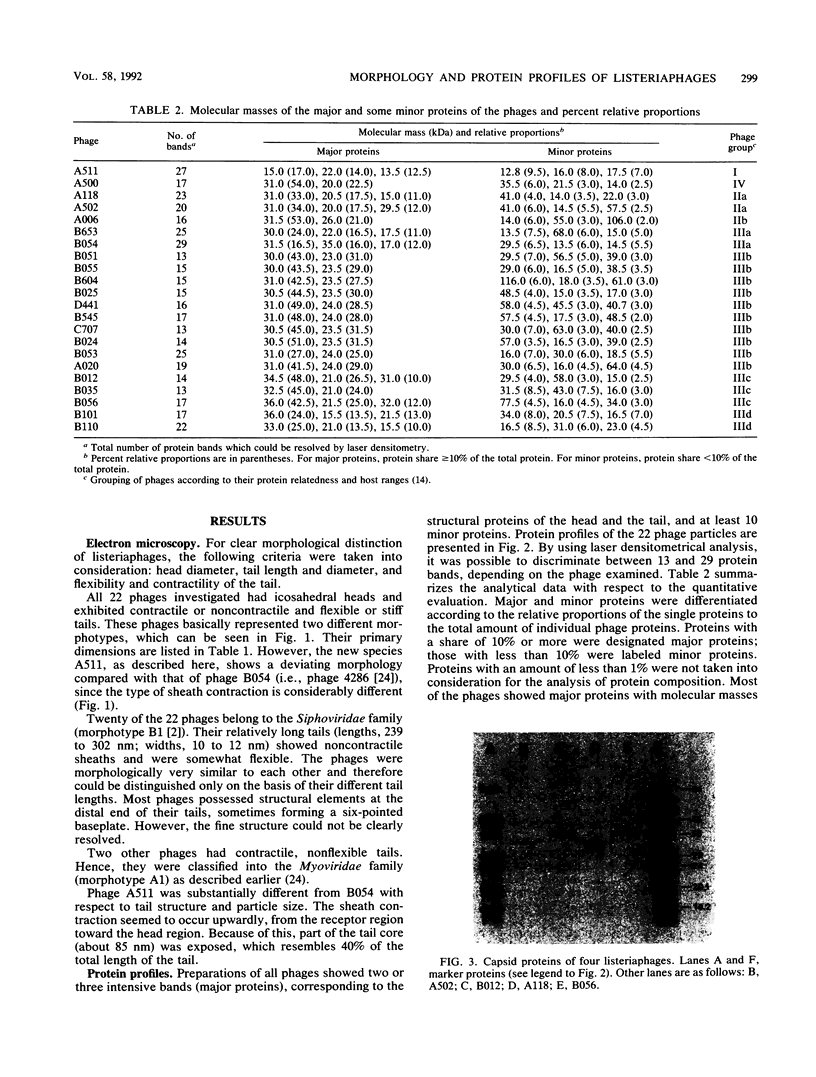
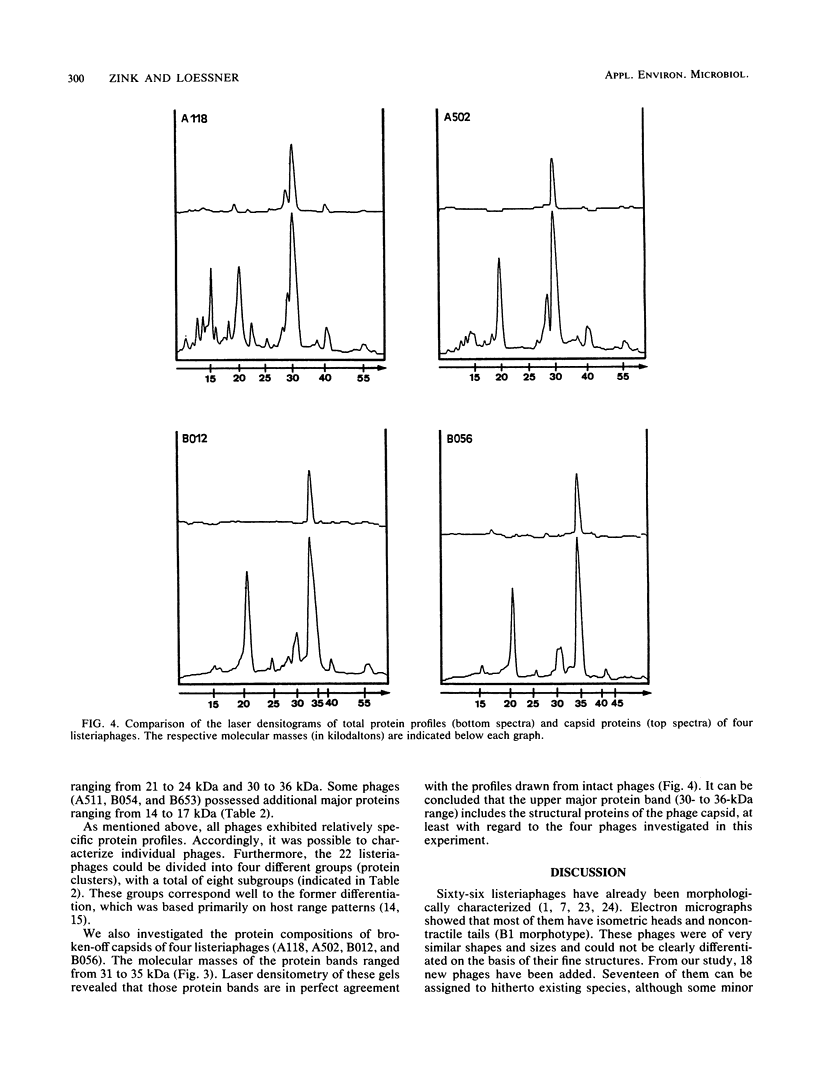
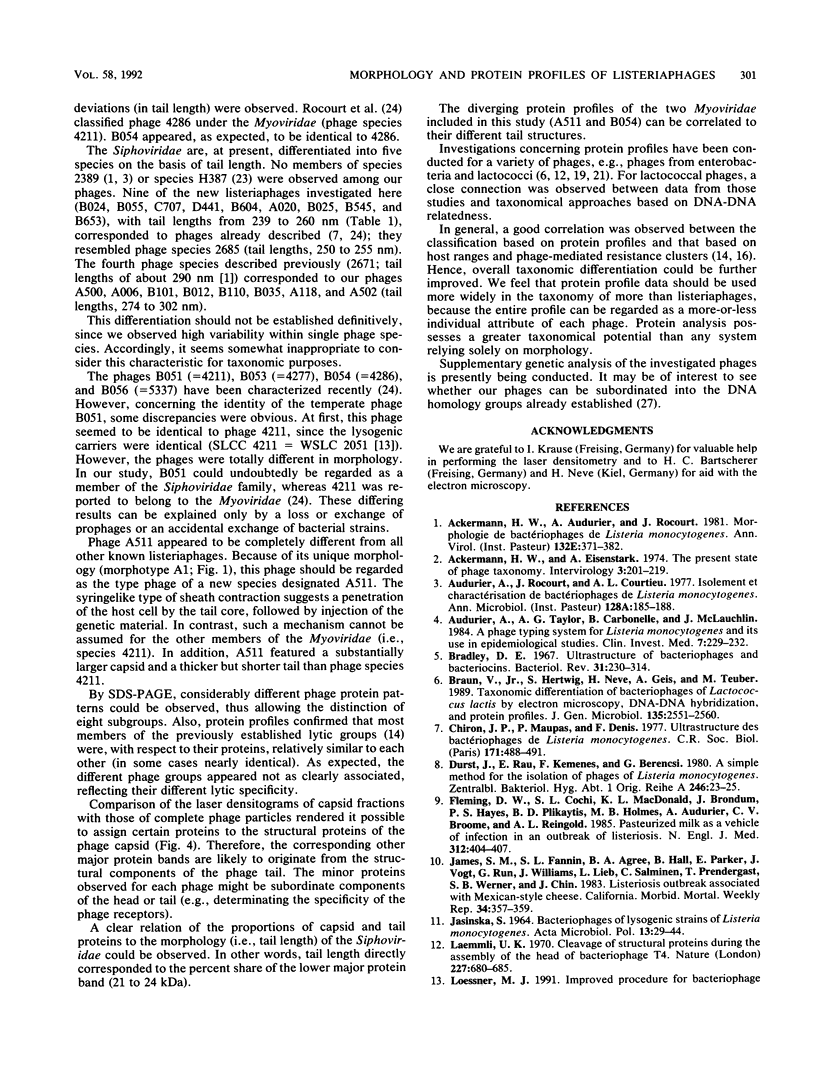
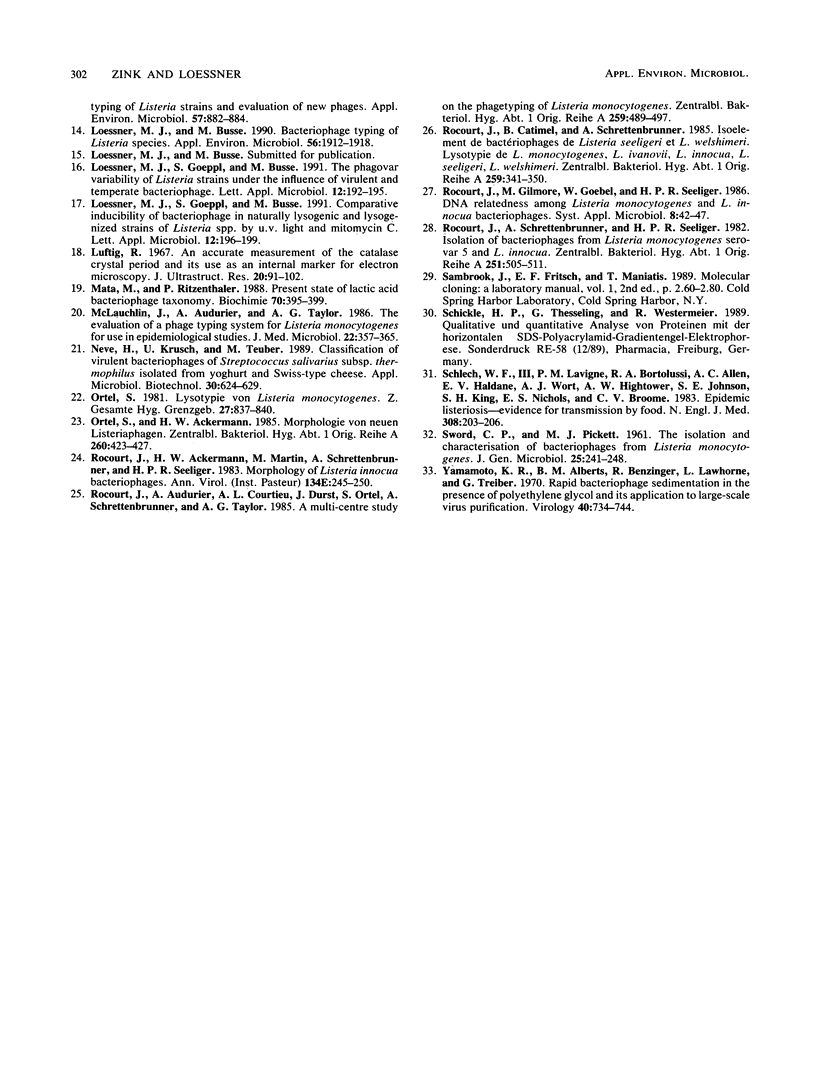
Images in this article
Selected References
These references are in PubMed. This may not be the complete list of references from this article.
- Ackermann H. W., Eisenstark A. The present state of phage taxonomy. Intervirology. 1974;3(4):201–219. doi: 10.1159/000149758. [DOI] [PubMed] [Google Scholar]
- Audurier A., Rocourt J., Courtieu A. L. Isolement et caractérisation de bactériophages de Listeria monocytogenes. Ann Microbiol (Paris) 1977 Feb-Mar;128(2):185–198. [PubMed] [Google Scholar]
- Audurier A., Taylor A. G., Carbonnelle B., McLauchlin J. A phage typing system for Listeria monocytogenes and its use in epidemiological studies. Clin Invest Med. 1984;7(4):229–232. [PubMed] [Google Scholar]
- Bradley D. E. Ultrastructure of bacteriophage and bacteriocins. Bacteriol Rev. 1967 Dec;31(4):230–314. doi: 10.1128/br.31.4.230-314.1967. [DOI] [PMC free article] [PubMed] [Google Scholar]
- Chiron J. P., Maupas P., Denis F. Ultrastructure des bactériophages de Listeria monocytogenes. C R Seances Soc Biol Fil. 1977;171(2):488–491. [PubMed] [Google Scholar]
- Durst J., Rau E., Kemenes F., Berencsi G. A simple method for the isolation of phages from Listeria monocytogenes. Zentralbl Bakteriol A. 1980 Feb;246(1):23–25. [PubMed] [Google Scholar]
- Fleming D. W., Cochi S. L., MacDonald K. L., Brondum J., Hayes P. S., Plikaytis B. D., Holmes M. B., Audurier A., Broome C. V., Reingold A. L. Pasteurized milk as a vehicle of infection in an outbreak of listeriosis. N Engl J Med. 1985 Feb 14;312(7):404–407. doi: 10.1056/NEJM198502143120704. [DOI] [PubMed] [Google Scholar]
- JASINSKA S. BACTERIOPHAGES OF LYSOGENIC STRAINS OF LISTERIA MONOCYTOGENES. Acta Microbiol Pol. 1964;13:29–43. [PubMed] [Google Scholar]
- Laemmli U. K. Cleavage of structural proteins during the assembly of the head of bacteriophage T4. Nature. 1970 Aug 15;227(5259):680–685. doi: 10.1038/227680a0. [DOI] [PubMed] [Google Scholar]
- Loessner M. J., Busse M. Bacteriophage typing of Listeria species. Appl Environ Microbiol. 1990 Jun;56(6):1912–1918. doi: 10.1128/aem.56.6.1912-1918.1990. [DOI] [PMC free article] [PubMed] [Google Scholar]
- Loessner M. J. Improved procedure for bacteriophage typing of Listeria strains and evaluation of new phages. Appl Environ Microbiol. 1991 Mar;57(3):882–884. doi: 10.1128/aem.57.3.882-884.1991. [DOI] [PMC free article] [PubMed] [Google Scholar]
- Luftig R. An accurate measurement of the catalase crystal period and its use as an internal marker for electron microscopy. J Ultrastruct Res. 1967 Sep;20(1):91–102. doi: 10.1016/s0022-5320(67)80038-8. [DOI] [PubMed] [Google Scholar]
- Mata M., Ritzenthaler P. Present state of lactic acid bacteria phage taxonomy. Biochimie. 1988 Mar;70(3):395–400. doi: 10.1016/0300-9084(88)90213-1. [DOI] [PubMed] [Google Scholar]
- McLauchlin J., Audurier A., Taylor A. G. The evaluation of a phage-typing system for Listeria monocytogenes for use in epidemiological studies. J Med Microbiol. 1986 Dec;22(4):357–365. doi: 10.1099/00222615-22-4-357. [DOI] [PubMed] [Google Scholar]
- Ortel S., Ackermann H. W. Morphologie von neuen Listeria-Phagen. Zentralbl Bakteriol Mikrobiol Hyg A. 1985 Dec;260(4):423–427. [PubMed] [Google Scholar]
- Ortel S. Lysotypie von Listeria monocytogenes. Z Gesamte Hyg. 1981 Nov;27(11):837–840. [PubMed] [Google Scholar]
- Rocourt J., Audurier A., Courtieu A. L., Durst J., Ortel S., Schrettenbrunner A., Taylor A. G. A multi-centre study on the phage typing of Listeria monocytogenes. Zentralbl Bakteriol Mikrobiol Hyg A. 1985 Jul;259(4):489–497. doi: 10.1016/s0176-6724(85)80081-x. [DOI] [PubMed] [Google Scholar]
- Rocourt J., Catimel B., Schrettenbrunner A. Isolement de bactériophages de Listeria seeligeri et L. welshimeri. Lysotypie de L. monocytogenes, L. ivanovii, L. innocua, L. seeligeri et L. welshimeri. Zentralbl Bakteriol Mikrobiol Hyg A. 1985 May;259(3):341–350. doi: 10.1016/s0176-6724(85)80036-5. [DOI] [PubMed] [Google Scholar]
- Rocourt J., Schrettenbrunner A., Seeliger H. P. Isolation of bacteriophages from Listeria monocytogenes Serovar 5 and Listeria innocua. Zentralbl Bakteriol Mikrobiol Hyg A. 1982 Apr;251(4):505–511. [PubMed] [Google Scholar]
- SWORD C. P., PICKETT M. J. The isolation and characterization of bacteriophages from Listeria monocytogenes. J Gen Microbiol. 1961 Jun;25:241–248. doi: 10.1099/00221287-25-2-241. [DOI] [PubMed] [Google Scholar]
- Schlech W. F., 3rd, Lavigne P. M., Bortolussi R. A., Allen A. C., Haldane E. V., Wort A. J., Hightower A. W., Johnson S. E., King S. H., Nicholls E. S. Epidemic listeriosis--evidence for transmission by food. N Engl J Med. 1983 Jan 27;308(4):203–206. doi: 10.1056/NEJM198301273080407. [DOI] [PubMed] [Google Scholar]
- Yamamoto K. R., Alberts B. M., Benzinger R., Lawhorne L., Treiber G. Rapid bacteriophage sedimentation in the presence of polyethylene glycol and its application to large-scale virus purification. Virology. 1970 Mar;40(3):734–744. doi: 10.1016/0042-6822(70)90218-7. [DOI] [PubMed] [Google Scholar]



